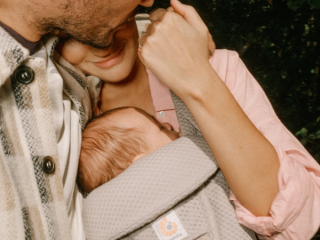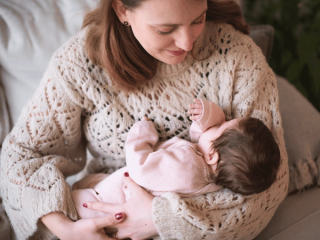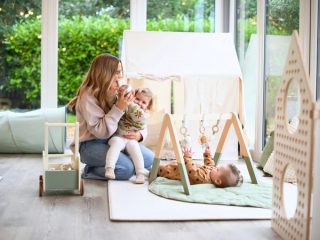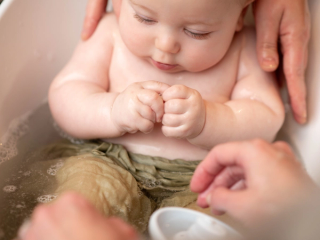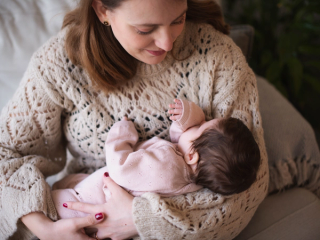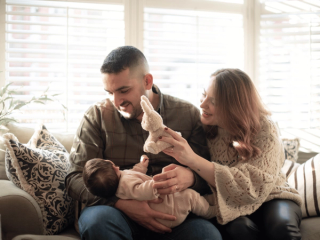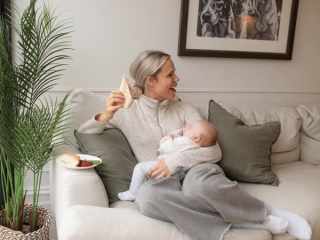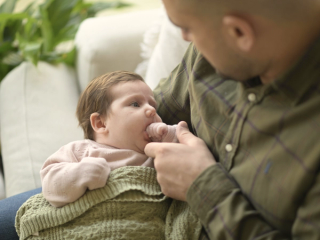
- Home
- Advice Hub
- Newborn
- New Parent Support
- Travelling With A Baby – What You Need To Know
Travelling with a baby – What you need to know
Discover essential tips for traveling with a baby. From packing advice to soothing techniques, this guide helps make your journey smooth and stress-free.
Whether it’s “up, up and away” or "up, up and stay,” planning a family vacation for the first time can be daunting. We’re here to answer all your questions about travelling with a baby, plus we’ve got some great tips to help you make the most of baby’s first holiday and enjoy that well-earned vacation (or staycation).
Is it a good idea to go on holiday with your baby? We say yes! Babies are quite transportable, so why not make the most of not having to pay for their flights and take a vacation together?
What is a good age to start travelling with a baby?
The answer is – it’s up to you. You can travel as soon as you feel ready, so long as your baby is fit and well. Travelling with a newborn is sometimes easier because they sleep a lot and there’s no danger of them running up and down the aeroplane aisles. But you also have to consider your own health and wellbeing – and your baby’s developing immune system – before deciding when and where to go.
At 3-6 months you’re more likely to be in a better routine and can still take advantage of your baby’s relative lack of mobility to port them around everywhere, but you may find nap times restrict your activities while you’re away.
After 6 months, food and mobility become more of a factor, but on the plus side your baby is more likely to notice what’s going on around them. Travelling can be an exciting sensory experience.
After they turn 1, it can be harder to keep your little one entertained on long journeys, but you will also be less bound by nap times and can have more fun exploring together.
So really you just need to weigh up the pros and cons for your family, taking into account the type of travel and what’s on offer at your destination.
What’s the best way to travel with a baby?
Again, this really depends on your baby and what you’re comfortable with. Whether you choose to fly, drive or even travel by train, just be sure you’re well prepared for every eventuality.
Flying with a baby
There are several things to consider when you’re flying with a baby. First, it’s worth noting that the carry-on limits that usually apply to fluids don’t apply to infant milk, sterilised water, or baby food. (Though you might be asked to taste them when you’re going through security!) Take more than you think you’ll need in case the flight gets delayed, and bear in mind that babies also gets quite dehydrated while flying so you may need to offer extra feeds.
In terms of other carry-on items, make sure you bring plenty of nappies, wipes and at least one change of clothes in case of any accidents! The last thing you want to do is hold onto a smelly, uncomfortable baby for several hours in an enclosed space. Bringing plenty of things in your carry-on also gives you some security if your checked luggage goes missing.
You can help ease any pain from changes in air pressure during take-off and landing by breastfeeding or bottle feeding or offering a dummy. During the flight, you can walk around with your baby to help distract them if they’re unsettled. And if you’re worried about being the noisiest ones on the flight, don’t be. You’ve got just as much right to be on board as anyone else has. (And many of those passengers will have been in your shoes!)
For ease around the airport, you can use your pushchair right up until you board the plane; the staff will take it from you at the end of the jetway and tag it to go into the cargo hold so that it’s ready when you get to the other end.
Road trip with a baby
If a car journey is in the offing, it’s a smart idea to plan in plenty of stops for feeding, nappy changes and to get your baby out for a stretch and a look round. Remember, also, that it’s recommended babies spend no more than 2 hours in their car seat at a time, as the car seat doesn’t allow them to be in the preferred lie-flat position.
For very long journeys, some savvy parents travel at night, when their baby is asleep. You might also want to take some new toys and bring them out at intervals throughout the journey to keep your little one amused.
If you’re travelling as a family of three, consider taking it in turns to spend some time sitting in the back of the car with your baby so that you can entertain them as you travel. Because baby car seats are rear facing, you can sit beside them and maintain good eye contact, sing, play and chat as you’re travelling. That way you’ll also be aware of any urgent nappy changes required!
Things to pack when travelling with a baby
Whether you’re travelling by car or flying, babies have a lot of paraphernalia! While there are some things on the checklist that are absolute must-haves, some are less essential, so think about what you really need and what you’re willing to carry.
- Food and milk – If you’re formula feeding and travelling to a country where the tap water is not safe to drink, consider taking ready-to-drink formula milk with you for ease. Remember you’ll need plenty of bottles and sterilising kit. If you’re weaning your little one, it’s easiest to pack ready-made baby foods so you know exactly what your baby is getting.
- Nappies, wipes, cream – Take plenty with you, but remember you can pre-order from shops like Boots to collect at the airport and carry on. (Check hand luggage guidance from your airline to see what your allowance is.) You can also, of course, buy these things once you’re on holiday, but bear in mind for sensitive skin the ingredients may be different. And if you’re planning on taking baby in the pool, remember to pack swim nappies!
- Clothes – Pack for comfort rather than style and remember that babies’ skin is particularly sensitive to the sun, so it’s best to cover up even when it’s hot. (Don’t forget sunhats!) Choose light, natural fabrics such as cotton for ultimate breathability – and don’t forget to pack extra for the inevitable nappy explosions! Washing detergent or a stain removal soap bar might also come in handy.
- Skin care – Sunscreen is a must, and you might also want to take your own baby bubble bath and shampoo. Again, if your baby has sensitive skin, consider taking your own towels in case they don’t get on with the hotel laundry detergent. Depending on how quickly your baby’s nails grow, you might need to bring nail clippers with you as well.
- Transport – Buggies are always useful, but do you need the full kit, or could you make do with a stroller? Much lighter to haul around! Consider also taking a sling, wrap or carrier, depending on your baby’s size, which will give you more flexibility on difficult surfaces. If you’re flying, do you need to take a car seat with you? Check with your holiday provider to see how transfers are managed.
- Sleeping – Do you need a travel cot, or is one provided? If one is provided, consider taking your own sheets – which will smell familiar – and don’t forget your baby’s sleeping bag. Hotel air conditioning can be quite intense, so you might need a warmer sleeping bag than you think.
- Toys – One or two toys might help ease boredom on long journeys, and of course if they have a favourite cuddly bring it with you, but generally speaking you don’t need to pack a load of toys for your holiday. Your baby will be fascinated by their new surroundings!
Tips for travelling with a baby
Going somewhere sunny? Babies can dehydrate very quickly in a hot climate, so it’s important to make sure that they have plenty of fluids. If you’re breastfeeding, you can do this by offering extra breastfeeds, in addition to increasing the amount of water you drink, too.
If you’re formula feeding or weaning your baby, then you could offer cool boiled water in between feeds to prevent them from becoming dehydrated. (Make sure the local water is safe to drink, or if using bottled water check the label to be sure the sodium levels aren’t too high – more on this below.)
Babies are sensitive to even small amounts of fluid loss so be aware of the signs of dehydration:
• fewer wet nappies
• sunken soft spot/fontanelle
• becoming drowsy
• dry mouth and no tears when crying
If you’re heading to colder climates, layers are key – though most well-meaning parents tend to actually bundle their little ones up more than necessary! We lose much of our body heat through our heads, so making sure your baby has a hat on, and that tiny fingers and toes are covered to prevent frostbite, will go a long way toward keeping things comfortable. And don’t forget to strip back several layers when you go inside, or your little one will get hot and cranky very quickly!
Hot weather makes us all dehydrated, so it’s important to keep your fluids up and offer your baby more feeds than usual. You might even notice that your breastmilk looks different, as it adapts to the heat. Clever!
Though you don’t usually have to worry about cleaning your breast before breastfeeding, if you’re slathered in sun cream, it might be worth giving your boob a wipe before latching baby on – just in case they get a mouthful!
And, as feeding in the heat can be a sticky business, you could try a different position or invest in a portable feeding pillow that stops baby’s sweaty head sticking to your sweaty arm.
If you’re using powdered formula whilst you’re abroad, it’s best to make it up with cooled, boiled bottled water, not tap water as you do at home. When you’re buying bottled water, though, check the label: the amount of sodium (Na) should be less than 200mg per litre and sulphate (SO or SO4) should be less than 250mg per litre.
Given all this trickiness, some families prefer to just take ready-to-feed formula with them on holiday. If you need to buy more formula whilst you’re away, it’s a good idea to check the manufacturer’s website first, as names and ingredients can vary from country to country.
To stay safe in the sun, you’ll want to use a very high factor sun cream, preferably one with SPF 50 or above and apply it to your little one at least half an hour before you venture outside. Remember you will need to reapply regularly, particularly after swimming (even if your sunscreen is waterproof).
If you are taking young ones into the sun, choose a time when it is less intense – i.e. outside of the hours when the sun is at its highest (between 11 am and 3pm). Young babies can burn very quickly, even with SPF 50 on, so you’re safest keeping your baby in the shade as much as possible.
Sunscreen is only one part of the job, though. Covering up with loose cotton clothing and a sunhat will also help protect sensitive skin. When you’re out and about, you can use a sun shield in the car and a sun canopy on your buggy. People often make the mistake of covering their buggy with a muslin to keep the sun off baby’s face – but this can create a dangerously hot environment for your little one, so it’s best to use an approved sunshade or set up a homemade canopy that allows plenty of airflow.
Special baby sunglasses will also protect their sensitive eyes – if you can get them to stay on! UV proof swimsuits and clothing are also a good way of keeping the sun’s rays at bay.
If you’re headed somewhere tropical, mosquitoes might be an issue. Insect repellents are suitable from different ages so always make sure you check the one you are buying is suitable for your child's age. For example, insect repellents containing DEET aren’t suitable for children under 2 months.
For very young travellers, your best bet may be to invest in a net that you can use over your pushchair, especially at dusk and early in the morning, when mosquitoes are most active. At night, ensure all the windows and doors are shut and use the net on your baby’s cot. To help prevent mosquito bites, you can also turn on a mosquito plug-in before leaving your room in the evening, so that when you return after a couple of hours, any mosquitoes will have been killed. (If, after all this, your baby is unlucky enough to get bitten, you can ease the itch with a cool, damp flannel.)
If you’re breastfeeding and you come down with traveller’s diarrhoea while you’re away, it’s best to continue breastfeeding; it is highly unlikely that you will pass it on to your baby.
Prevention is better than cure, so if you’re in a country where you can’t drink the tap water, try to eat only cooked, hot foods and avoid uncooked fruit, vegetables and salad unless they have been washed in safe water or can be peeled. Drink only bottled water and remember that washing your hands is the single most important thing you can do to prevent infections.
Enjoy your trip
In the planning, this trip may start to feel like more hassle than it is worth, but once you are settled into your new destination, you will realise that a change really can be as good as a rest! Time to start making memories.
Important notice
We recognise that breastfeeding is best, providing many benefits to both mothers and infants. We also recognise that every parenting journey is unique, and we are here to support you through this journey, however you choose to feed your baby.
If you choose to breastfeed it is important that you eat a healthy well-balanced diet in preparation for and during breastfeeding. Before deciding to combination or formula feed your baby, note that reducing or stopping breastfeeding can be difficult to reverse. Babies feed on demand, so replacing breastfeeding with infant formula milk may reduce your supply. Formula feeding has both social and financial implications. Talk to your midwife or health visitor for guidance and support.
If you choose to use formula milk, make sure you choose the right milk for your baby’s age and prepare and store it according to the instructions on the packaging. Not doing so may make your baby ill. Infant formula is a nutritionally complete breastmilk substitute that can be used from birth. From 6 months you can choose to use follow on milk as part of a mixed diet and from 12 months you have the option to move onto growing up milk alongside a balanced diet.
